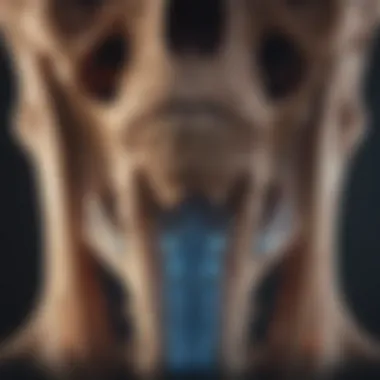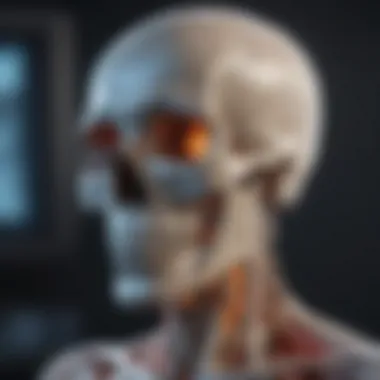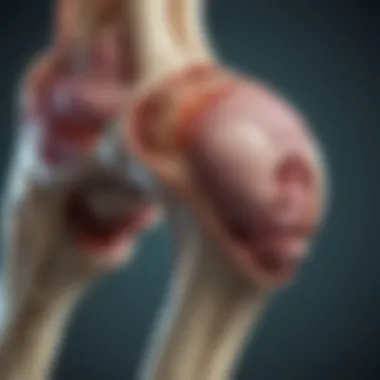Understanding Bone Scans for Prostate Cancer Diagnosis


Intro
Bone scans are a vital tool in evaluating and managing prostate cancer, especially when it comes to understanding the potential spread of the disease. For many patients, navigating the complexities of diagnosis and treatment can feel like wandering through a maze. The use of bone scans transforms some of this uncertainty, providing insights that guide clinicians in decision-making and treatment planning.
In the case of prostate cancer, cancer cells can travel and take root in the bones. Recognizing this is crucial as bone metastases significantly impact a patient’s prognosis and treatment options. This article will explore the mechanics of bone scans, their role in detecting bone metastases, and their relevance to the evolving landscape of prostate cancer management.
Research Overview
Summary of Key Findings
Recent studies highlight several key aspects about the use of bone scans in prostate cancer care:
- Early Detection: Bone scans can sometimes reveal metastases before symptoms present themselves, sparking earlier interventions.
- Treatment Response Assessment: Tracking changes in scan results can help doctors gauge how well a treatment is working.
- Integration with Other Imaging Techniques: Combining bone scans with MRI or PET scans increases diagnostic accuracy.
Relevance to Current Scientific Discussions
The discourse around bone scans is becoming more pointed amid rapid advancements in imaging technologies. As new imaging modalities emerge, the foundational role of bone scans is often reevaluated. Discussions in recent medical literature frequently center on:
- How to select patients who will benefit most from bone scans based on clinical indicators.
- The comparison of traditional bone scans with newer methods that offer increased specificity and sensitivity.
- The potential for personalized medicine to influence the decision-making process for imaging and subsequent treatment plans.
This shifting landscape emphasizes the importance of continual research into not just the scans themselves, but how they fit into the broader framework of prostate cancer treatment.
Closure
As the piece unfolds, we will delve deeper into the techniques behind bone scans, how to prepare for them, the possible risks involved, and the interpretation of results. Each aspect plays a pivotal role in comprehensive cancer care. By amalgamating knowledge on imaging techniques with clinical practices, we hope to provide clarity and understanding for medical professionals and patients alike.
Prelims to Bone Scans
Bone scans hold significant value in the context of prostate cancer. They serve as a critical tool in detecting bone metastases, which can occur when cancer spreads from the prostate to surrounding bones. Understanding bone scans not only unravels the mechanisms of this imaging technique but also provides insight into the broader landscape of prostate cancer diagnosis and management.
In this article, we will delve into the fundamental aspects of bone scans, outlining their relevance, benefits, and considerations that accompany this diagnostic process. Knowing when and why a doctor might opt for a bone scan can empower patients and their families to engage actively in medical discussions and decisions.
Defining Bone Scans
At its core, a bone scan is an imaging technique that allows healthcare professionals to visualize the state of bones within the body. It involves the use of a small amount of radioactive material, which is injected into a vein. The material, known as a radiotracer, travels through the bloodstream and gets absorbed by bone tissue, particularly areas where there is increased metabolic activity, such as infections, fractures, or tumors—I can give an example of how this method is utilized in clinical settings.
Bone scans are particularly noteworthy because they can reveal bone involvement from cancer earlier than many other diagnostic tests, providing critical information that can shape treatment options. Notably, this test is often employed alongside other imaging forms, enhancing the overall understanding of a patient's condition.
Historical Context
The journey of bone scans began in the 1950s when the quest for better diagnostic resources in medicine took flight. The introduction of radioactive isotopes marked a turning point. Early bone scans primarily utilized sodium phosphate labeled with different isotopes. In those days, interpreting the results required a good deal of intuition and experience, as the technology was still developing.
As the decades rolled on, advancements in both radiotracer technology and imaging techniques evolved the field immensely. The arrival of single-photon emission computed tomography (SPECT) in the late 1990s brought sharper and more accurate images, allowing for more nuanced assessments. Now, professionals can observe bone metabolism in real time, vastly improving prostate cancer management protocols.
Understanding this historical context accentuates how far bone scanning has come, transitioning from a nascent diagnostic tool into a mainstay in oncological practices today.
Prostate Cancer Overview
Understanding prostate cancer is crucial for navigating the landscape of bone scans and their role in diagnosis and treatment. Prostate cancer stands as one of the most prevalent malignancies amongst men, making it a significant concern for healthcare professionals and patients alike. The dynamics of this disease can greatly influence management strategies and imaging techniques like bone scans, which aid in assessment and treatment planning.
Epidemiology of Prostate Cancer
Prostate cancer isn't merely a statistic; it's a reality that resonates with the lives of millions. In fact, according to recent data from the American Cancer Society, one in eight men will be diagnosed with prostate cancer in their lifetime. This striking figure underscores the magnitude of the issue and the need for effective screening and diagnostic tools.
- Age Factor: The risk of developing prostate cancer increases notably after the age of 50, highlighting the importance of regular screenings for older men.
- Ethnic Disparities: It's observed that African American men face higher incidence rates compared to men of other races. Moreover, they also tend to have more aggressive forms of cancer, necessitating tailored treatment strategies.
- Genetic Factors: There is growing recognition of the hereditary aspect, with certain inherited gene mutations heightening cancer risk. Families with a history of prostate cancer should encourage discussions around genetic counseling and screening.
Furthermore, disparities in access to healthcare can influence outcomes. Adequate awareness and understanding of this disease can lead to earlier diagnosis and improved survival rates.
Pathophysiology
To appreciate the role of bone scans, it's essential to delve into the underlying mechanisms of prostate cancer. Fundamentally, prostate cancer originates from the glandular cells of the prostate, where alterations in the cellular environment lead to uncontrolled growth. As cancer progresses, the cells can invade nearby tissues and metastasize, particularly to the bones.
- Hormonal Influence: Androgens, like testosterone, fuel the growth of prostate cancer cells. Many treatment modalities center on lowering androgen levels or blocking their action, which can slow disease progression.
- Metastatic Behavior: Once it spreads, prostate cancer often seeks refuge in the skeletal system. Bone metastases are commonly seen in advanced stages and can significantly impact a patient's quality of life due to pain and fractures.
Pathophysiologically, the interplay between cancer cells and the bone microenvironment is complex. Tumor-derived factors can stimulate osteoclast activity, leading to bone resorption and pain. Understanding these mechanisms empowers oncologists and radiologists to utilize bone scans effectively for monitoring and treatment planning.
"Detecting bone metastases early can change the trajectory of prostate cancer treatment, enabling timely interventions that can significantly enhance patient outcomes."
In summary, having a comprehensive grasp of the epidemiology and pathophysiology of prostate cancer sets the stage for understanding the diagnostic utility of imaging techniques like bone scans. This foundation not only aids clinicians in clinical decision-making but also equips patients with knowledge to engage in informed discussions about their care.
The Role of Imaging in Prostate Cancer
Imaging plays a critical role in the diagnosis and management of prostate cancer. It provides insights not only into the disease's presence but also into its potential spread, offering a roadmap for treatment options. In the case of prostate cancer, understanding the various imaging techniques is essential because these methods contribute significantly to forming an accurate and comprehensive picture of a patient’s individual health status. With imaging, medical professionals can accurately assess the extent of the cancer, which is paramount for determining the most effective treatment approach.
Moreover, imaging informs clinical decision-making by assessing how well treatments are working, monitoring the progression of cancer, and identifying any side effects. The results derived from imaging can radically influence treatment plans—for instance, transitioning a patient from a local to an advanced-stage treatment option requires a precise understanding of the patient’s condition.
In sum, imaging is not merely a supplemental tool; it acts as a backbone for informed clinical choices, ultimately enhancing patient outcomes.
Various Imaging Techniques
Several imaging techniques are utilized in the diagnosis and management of prostate cancer. Each method comes with its unique strengths and weaknesses.


- Ultrasound: Doppler ultrasound can distinguish between benign and malignant tissues by measuring blood flow, aiding in early diagnosis.
- Magnetic Resonance Imaging (MRI): MRI is particularly valuable for visualizing the prostate and surrounding structures. It offers detailed images that help in staging the cancer and treatment planning.
- Computed Tomography (CT) Scans: While not exclusively for prostate evaluation, CT scans play a role in identifying metastases in the abdomen and pelvis.
- Bone Scans: Specific to assessing bone metastases, these scans can detect changes in bone metabolism, making them crucial for diagnosing the spread of prostate cancer.
Each of these modalities serves as an essential cog in the diagnostic wheel, where the use of one can complement the results of another for a more holistic view of the patient's condition.
Significance of Bone Scans
The significance of bone scans in the context of prostate cancer is undeniable. These scans are vital in detecting bone metastases, which can significantly affect treatment choices and prognosis. When prostate cancer spreads, it often invades the bones, causing pain and increasing the risk of fractures.
Bone scans utilize radiotracers that are picked up by areas of increased bone activity. Hence, they serve as a powerful tool in identifying whether the cancer has metastasized. Key reasons for the significance of bone scans include:
- Early Detection: Bone scans can identify metastatic lesions before traditional imaging methods might detect them, indicating treatment needs sooner.
- Treatment Planning: The results from a bone scan can guide treatment decisions. For instance, a positive scan may lead to more aggressive systemic therapies.
- Monitoring Response to Treatment: Bone scans can help evaluate how well a treatment is working, guiding ongoing care.
Bone scans are instrumental in offering healthcare providers a clear view of the cancer's impact on the patient’s skeletal system, thus allowing for tailored, effective treatment strategies.
Mechanics of Bone Scans
Bone scans are pivotal in diagnosing and managing prostate cancer, serving as a crucial tool for clinicians and patients alike. Understanding how these scans operate enhances one’s comprehension of their significance in the clinical setting. The mechanics of bone scans not only reveal anomalies in bone structure but also offer insights into underlying metabolic processes. Patients undergoing these procedures can gather valuable information regarding their health status and treatment trajectory.
How Bone Scans Work
A bone scan is a type of nuclear imaging that provides crucial details about bone metabolism. The process starts with the administration of a radiotracer, typically a compound containing technetium-99m. When this radiotracer is injected into the bloodstream, it travels throughout the body and is absorbed by bones, particularly those undergoing abnormal changes like inflammation or metastasis.
Once the radiotracer collects in the bones, a specialized camera captures images. These images reveal areas of increased or decreased activity, which correspond to various bone conditions.
Key steps in how bone scans work include:
- Injection of radiotracer: The radiotracer is administered intravenously.
- Waiting period: Patients usually wait for a few hours to allow the tracer to accumulate in the bones.
- Imaging: A gamma camera is used to capture the radiation emitted from the radiotracer as it decays.
Bone scans excel at detecting changes that other imaging modalities might miss, particularly when it comes to subtle bone lesions or metastatic sites not clearly visible on X-rays or CT scans. This makes them instrumental in assessing cancer spread, especially in prostate cancer patients, whose survival and quality of life can hinge on timely intervention.
Radiotracer Use
The selection of the radiotracer is a vital factor in the effectiveness of a bone scan. The commonly used radiotracer, technetium-99m-methylene diphosphonate (MDP), is preferred due to its affinity for areas of high bone turnover. This characteristic enables it to bind effectively to altered bone surfaces, illuminating potential problem areas.
Radiotracers serve multiple functions:
- Detection of metastasis: They highlight areas where prostate cancer cells may have spread to the bones.
- Assessment of degenerate conditions: This includes areas impacted by arthritis or other non-cancerous conditions.
An important consideration is that while the radiotracer helps in visualization, its half-life allows for sufficient imaging while minimizing radiation exposure. This balance is critical, especially for individuals who may undergo multiple scans throughout their treatment journey.
Patients should be informed about the use of radiotracers, particularly regarding how these substances work and the expected duration for which they remain in the body. Addressing these topics can alleviate any concerns, fostering a smooth scanning experience.
"Understanding the mechanics of bone scans is fundamental in appreciating their role in improving outcomes for prostate cancer patients."
In summary, the mechanics of bone scans encompass the processes from radiotracer administration to image interpretation. This knowledge not only enhances patient compliance and acceptance but also underlines the scan's significance in the realm of prostate cancer management.
Indications for Bone Scans
When it comes to managing prostate cancer, understanding when to utilize bone scans is crucial. Bone scans are specialized imaging tests that help detect abnormalities in the bones. Their relevance is amplified in the context of prostate cancer due to the propensity for this type of cancer to spread to the bones. Recognizing the right circumstances for a bone scan can significantly affect patient outcomes and treatment directions.
When to Order a Bone Scan
So, when exactly should a bone scan be ordered? There are several scenarios in the clinical journey of a prostate cancer patient where a bone scan becomes vital.
- Elevated Prostate-Specific Antigen (PSA) Levels: If a patient exhibits elevated PSA levels, particularly when there's a concern about metastasis, a bone scan can provide clarity on whether the cancer has spread.
- Evidence of Symptoms: Patients reporting bone pain, unexplained fractures, or other skeletal-related symptoms warrant a bone scan to rule out metastatic disease.
- Pre-Treatment Evaluation: Before starting certain treatments like hormone therapy or radiotherapy, a scan might be performed to establish a baseline.
- Progression Monitoring: For ongoing monitoring of prostate cancer, bone scans help assess whether the disease is stable or worsening.
The above points underscore that the decision to perform a bone scan isn’t taken lightly; it involves careful consideration by healthcare professionals.
Clinical Scenarios
In clinical practice, the decision to utilize a bone scan often reflects real-life patient situations. Let’s explore a few scenarios that demonstrate the utility of bone scans in the diagnosis and management of prostate cancer:
- Diagnosis of Metastatic Disease: During a routine follow-up, an individual with known prostate cancer presents with persistent back pain. Given his history, the healthcare provider may recommend a bone scan to check for metastatic lesions.
- Post-Treatment Evaluation: A patient who has completed his treatment for prostate cancer might undergo a bone scan to ensure there are no residual bone lesions before committing to further treatment pathways, like surgery or radiation.
- Assessing Treatment Efficacy: After initiating a treatment regimen, healthcare teams may use bone scans to evaluate treatment effectiveness. If the scan shows reduced uptake of radiotracers in previously affected bone areas, this could indicate a positive treatment response.
- Clinical Trials: For patients enrolled in clinical trials evaluating new therapeutic approaches, bone scans may be incorporated into the protocol to monitor bone health and cancer progression throughout the study.
In addition to these specific examples, the nuances of each patient case can influence when and how bone scans are integrated into their care. It's important to communicate openly with your healthcare team about the reasons for a bone scan, what it entails, and how it may impact treatment decisions moving forward.
"The proper use of imaging techniques like bone scans can lead to more targeted therapies, ultimately benefiting patient outcomes in prostate cancer management."
In summary, understanding the indications for bone scans in prostate cancer is essential for timely diagnosis, treatment planning, and monitoring disease progression. As cancer treatment continues to evolve, so do the parameters guiding when these scans are deemed necessary, highlighting the importance of personalized patient care.
Preparing for a Bone Scan
Preparing for a bone scan is a crucial step in ensuring accurate results and a smoother experience for patients undergoing this imaging procedure. The process involves several considerations that can significantly influence the quality of the scan and the subsequent interpretation of the findings. Understanding these pre-scan elements not only optimizes the results but also alleviates patient anxieties about the unknown aspects of the procedure.
Pre-Scan Considerations
Before the actual bone scan takes place, there are specific factors patients should keep in mind. These considerations cover both lifestyle choices and medical factors that might impact the scan.
- Medical History: Patients should provide a complete medical history, including any previous illnesses, surgeries, allergic reactions, and current medications. This information can affect how the scan is conducted and help the medical team prepare adequately.
- Medication Instructions: It’s important to consult with a healthcare provider regarding medications. Certain substances, particularly those that affect bone density or metabolism, may need to be temporarily adjusted prior to the scan.
- Hydration: Staying sufficiently hydrated can enhance the effectiveness of the imaging process. Drinking water prior to the scan can help wash out any remnants of previous medications or substances that may interfere with the test.
- Dietary Restrictions: Depending on the specifics of the imaging procedures, there may be dietary restrictions in the hours leading up to the scan. This may involve avoiding heavy meals or certain supplements.
"An informed patient is an empowered patient; understanding the process can often lead to improved outcomes."
- Clothing and Accessories: Patients are advised to wear comfortable clothing without any metal components. Jewelry, belts, and other accessories should be removed, as they can lead to artifacts in the bone imagery.
- Coordination with Healthcare Providers: Prior to the appointment, confirming the scan details with the healthcare provider can be beneficial. This not only ensures the accurate scheduling of the scan but also allows patients to clarify any concerns they may have regarding the process.


Patient Instructions
While healthcare providers will guide patients through the preparations, having a set of clear instructions can be immensely helpful. Here are some key instructions for patients:
- Arrive on Time: Punctuality ensures that all necessary pre-scan protocols can be followed without rushing.
- Bring Necessary Documents: Patients should carry any required documentation, including identification, insurance information, and medical referrals, if needed.
- Discuss Concerns Openly: Patients should feel encouraged to voice any worries or questions. This could range from queries about the radiotracer used to the implications of the results.
- Post-Scan Instructions: Prepare for post-scan actions. In some cases, specific care or follow-ups may be needed, so understanding this in advance can minimize confusion later.
- Follow-Up Appointments: Scheduling a follow-up appointment for result interpretation can be useful, ensuring that patients are fully aware of next steps in their treatment path.
By understanding the pre-scan considerations and following their instructions closely, patients can navigate this aspect of their care journey with greater ease and clarity. This preparation ultimately sets the stage for effective imaging and informed decision-making regarding their treatment for prostate cancer.
The Procedure of a Bone Scan
The procedure of a bone scan is a pivotal aspect in the exploration of prostate cancer diagnostics. Understanding how this imaging technique is carried out not only enhances a patient’s comfort but also underlines its significance in treatment planning. Practically speaking, a bone scan helps to identify metastatic sites, guiding further therapeutic decisions and interventions. This section elucidates the systematic approach to a bone scan while providing insights regarding its operation and purpose.
Step-by-Step Overview
A bone scan procedure can be divided into several essential steps to ensure clarity and preparation for patients undergoing the test. Each stage serves a specific function, contributing to the effectiveness of the outcome.
- Initial Consultation: Before the procedure begins, patients usually have a discussion with their healthcare professionals. This covers information about the scan, what it involves, and its objectives.
- Radiotracer Injection: The patient receives an injection of a radioactive tracer, typically administered in a vein in the arm. This tracer is crucial as it allows for the imaging of bone metabolism.
- Waiting Period: After the injection, there’s a waiting period—often ranging from 2 to 4 hours. This time allows the tracer to accumulate in the bone areas where there is increased metabolic activity, which may indicate the presence of tumors or other abnormalities.
- Scanning Process: Once the waiting period elapses, the patient lies down on a scanning table as a gamma camera passes over their body. This camera detects the radiation emitted by the tracer, creating images of the bones. The entire scanning session may take approximately 30 to 60 minutes, depending on the requirements.
- Post-Scan Discussion: After the procedure, patients may go over initial findings with their healthcare provider if immediate feedback is available. Otherwise, a follow-up appointment will likely be scheduled for comprehensive results.
"Understanding the step-by-step process of a bone scan not only alleviates anxiety but also prepares patients for what lies ahead."
Duration of the Procedure
The duration of a bone scan can be broken down into its various components. Overall, the entire process is not exceedingly lengthy, making it generally feasible for most patients.
- Radiotracer Injection: This part is fairly quick—usually just a few minutes for the injection.
- Waiting Time: This is the most time-consuming aspect, often demanding 2 to 4 hours to allow the tracer to distribute adequately. While this might seem long, it’s a crucial step before imaging.
- Scanning Time: The actual scanning takes about 30 to 60 minutes. During this phase, patients must remain still, but they are generally comfortable on the table.
In total, patients should anticipate dedicating around 3 to 5 hours for the entire experience, from consultation through to the end of the scan. Being informed about this timeline can better equip patients for the procedure, minimizing confusion and concerns.
Understanding the importance of the procedural flow and the duration involved in a bone scan can significantly impact the overall patient experience, relieving anxiety around what can be, for some, an intimidating diagnostic journey.
Risks and Considerations
In the realm of medical imaging, particularly with bone scans in prostate cancer assessment, understanding the associated risks and considerations is crucial. Although bone scans are generally deemed safe and valuable, it’s important to be mindful of both the potential risks involved and the concerns patients may harbor regarding the procedure. A well-informed approach can empower both patients and healthcare providers, ensuring optimal outcomes.
Potential Risks of Bone Scans
Bone scans utilize radioactive materials, known as radiotracers, which typically pose minimal risk to patients. However, it’s imperative to be aware of the following potential risks:
- Radiation Exposure: Even though the amount of radiation used in a bone scan is small, some individuals may be concerned about the cumulative risks associated with repeated exposure. The radiation is equivalent to that received from several standard X-rays but is a vital part of the diagnostic process.
- Allergic Reactions: In rare cases, patients may experience allergic reactions to the radiotracer. While uncommon, it’s essential for radioactively linked substances to be monitored, especially in patients with known allergies.
- Kidney Function: Since the radiotracers are excreted through kidneys, individuals with pre-existing kidney issues should discuss their conditions with their healthcare providers before undergoing the procedure. This ensures that renal function is not compromised further.
It’s also worth noting that the benefits, usually outweigh the risks, given the heightened need for accurate imaging in prostate cancer. Below, a brief comparison illustrates the value of undergoing a bone scan in detecting potential metastatic disease:
- Early Detection: Bone scans can show abnormal findings before symptoms arise.
- Guidance in Treatment Decisions: Results can lead to proactive treatment plans that may improve patient outcomes.
- Non-Invasive Technique: Unlike some other imaging methods, bone scans do not require incisions, minimizing discomfort and risk of infection.
Addressing Patient Concerns
Patient anxiety regarding bone scans often stems from a lack of understanding about the procedure and its implications. Addressing these concerns head-on fosters a sense of trust. Here are a few approaches:
- Clear Communication: Healthcare providers can explain the procedure in straightforward terms, breaking down every step and answering patient queries.
- Education Materials: Providing brochures or websites, such as Wikipedia, can keep patients informed about what to expect, potential risks, benefits, and how results influence treatment.
- Emotional Support: Many patients experience anxiety before clinical procedures. Offering reassurance and addressing specific worries, such as the safety of the radiotracer, can go a long way.
- Involving Family: Encouraging patients to bring family or close friends during consultations can alleviate stress. Loved ones can provide additional support throughout the process.
Ultimately, the goal is to ensure that patients feel comfortable and informed about their health choices. They should understand the importance of a bone scan, while also recognizing any potential risks involved.
"Knowledge is power. The more patients understand about their procedures, the more confident and secure they feel."
Through transparency and engagement, healthcare providers can successfully navigate the landscape of risks and considerations associated with bone scans. It’s paramount for all involved parties to collaborate closely, providing a comprehensive strategy that accommodates patient needs and maximizes diagnostic precision.
Interpreting Bone Scan Results
Bone scans play a pivotal role in the management of prostate cancer, particularly when it comes to identifying and monitoring the presence of bone metastases. Understanding these results is essential not just for healthcare professionals but also for patients and their families who navigate through the complexities of cancer treatment. The interpretation of bone scan results is a blend of science and art—where clinical knowledge meets the nuances of imaging technology.
Understanding the Images
Bone scans utilize a radiotracer to highlight areas of high metabolic activity in the bones, which can indicate the presence of metastases. When viewing the images, radiologists assess various aspects:
- Hot Spots: These are areas that appear darker on the scan, suggestive of increased activity, perhaps due to cancer cells. They can be compared to the normal bone regions which remain relatively light.
- Pattern Recognition: Patterns can tell a lot; for instance, the distribution of hot spots may align more with metastatic prostate cancer rather than other conditions like arthritis or fractures.
- Comparison with Other Studies: A comprehensive interpretation doesn’t solely depend on the images from the bone scan. Correlating these findings with previous imaging studies like CT or MRI can provide a full picture.
Understanding these images requires a solid foundation in medical knowledge and experience to differentiate between benign and malignant lesions. This critical distinction can dictate subsequent care and treatment decisions.
Radiologist's Role
The radiologist is the unsung hero in the interpretation of bone scans. Their expertise shapes the subsequent clinical decisions that healthcare teams make regarding patient management.
- Critical Analysis: Radiologists must systematically evaluate the images, looking for anomalies while also taking the patient's history and symptoms into consideration. They must ask questions like: Are there previous imaging results to compare against? How does the patient's clinical status align with the scan outcomes?
- Communication: It's not just about interpreting images; effective communication is key. Radiologists draft comprehensive reports summarizing their findings and the implications of those findings for the treating physician. This bridge connects the technical insights from the scan to the practicalities of patient care.
- Collaboration: They often work in tandem with oncologists and urologists in multidisciplinary teams. This collaborative approach ensures that treatment plans are not only based on the bone scan results but also on the overall health status and preferences of the patient.
In light of the evolving landscape of prostate cancer treatment, the role of the radiologist is increasingly significant. The ability to interpret complex imaging results accurately can impact outcomes, making it vital for healthcare professionals and patients alike to understand the intricate narratives of bone scans.
Bone Scans and Treatment Planning
When it comes to managing prostate cancer, bone scans play a pivotal role in guiding treatment decisions. Understanding their implications can be a game changer in formulating an effective treatment plan.
How Results Affect Treatment Options
The results of bone scans can significantly influence the management strategies employed by healthcare providers. If a bone scan reveals evidence of metastatic activity, meaning that cancer has spread to the bones, it directly impacts treatment options. At this juncture, physicians often weigh various systemic therapies such as hormone therapy, chemotherapy, or newer agents like radium-223, depending on the extent of the disease.


For instance, in cases where limited spread is discovered, the oncologist may opt for local therapies, such as radiation, aimed at mitigating specific symptoms while still considering long-term systemic treatment options. Conversely, in the event of widespread metastatic lesions, more aggressive systemic treatments might become a priority. This tailored approach ensures that each patient receives care customized to their unique clinical picture, emphasizing the importance of bone scan results in determining the best course forward.
Case Studies
Examining real-world cases can illustrate how bone scans guide treatment planning. One notable case involved a 65-year-old male patient with prostate cancer whose bone scan exhibited multiple hotspots suggestive of metastatic spread. Following the imaging, the healthcare team decided to initiate a combined hormonal and radiopharmaceutical therapy approach. This decision stemmed from the understanding that managing pain effectively could greatly enhance the patient's quality of life.
Another example highlights a patient whose bone scan came back clear of metastatic lesions. Here, the clinical team opted for active surveillance rather than immediate treatment intervention, allowing the individual to maintain a normal life while closely monitoring the disease.
Comparative Imaging Techniques
In the realm of prostate cancer diagnosis and management, understanding the role of various imaging techniques is crucial, notably when it comes to making informed decisions about patient care. Comparative imaging techniques serve as a backbone for assessing the presence and extent of disease, thereby helping healthcare professionals choose the most effective diagnostic paths. Among these methodologies, CT scans, MRI, and bone scans each have their unique advantages, limitations, and clinical indications. This section provides a comprehensive look into how these tools stack up against one another in the context of prostate cancer.
CT and MRI vs. Bone Scans
When distinguishing between CT, MRI, and bone scans, one must consider their different approaches and the specific information they offer.
- CT Scans: Computed Tomography (CT) scanning uses X-rays to create highly detailed cross-sectional images of the body. It's particularly adept at identifying tumors and any associated changes in the structure of nearby tissues. However, it tends to be less sensitive in detecting smaller lesions specifically within bone tissue.
- MRI: Magnetic Resonance Imaging (MRI) utilizes powerful magnets and radio waves to generate detailed images of organs and tissues. It excels in visualizing the soft tissue surrounding bones, which is beneficial in prostate cancer diagnosis due to its high soft tissue contrast. Yet, MRI may not detect small metastatic disease in bones as effectively as bone scans.
- Bone Scans: Bone scans are uniquely designed for identifying metabolic activity in the bones. They utilize radiotracers that highlight abnormal areas of bone metabolism, often before structural changes occur, making them particularly valuable for early detection of bone metastases. However, they may not be specific enough; thus, they often require correlation with other imaging methods to confirm findings.
Ultimately, these imaging modalities complement each other in the management of prostate cancer. While CT and MRI offer insights into the anatomical structure and local disease extent, bone scans provide key data on bony involvement—highlighting the significance of a multidisciplinary approach in constructing a thorough patient evaluation.
Advantages of Bone Scans
Bone scans hold a special place in prostate cancer management for several compelling reasons:
- Early Detection of Metastasis: A primary advantage of bone scans is their capability to detect metastatic activity in bones before morphological changes are apparent. This allows for timely intervention, which can be fortuitous in improving patient outcomes.
- Whole Body Imaging: Unlike localized imaging techniques, bone scans assess the entire skeleton in a single examination. This comprehensive view can reveal widespread metastatic disease, which is particularly relevant in prostate cancer where bone metastases occur frequently.
- Functional Imaging: Bone scans focus on the functional aspect of the skeleton by highlighting areas of increased metabolic activity, often associated with cancer, infection, or trauma. This functional insight can lead to significant discovery of hidden issues not visible in other imaging techniques.
- Cost-Effectiveness: In many health care settings, bone scans can be more cost-effective than some other imaging studies, especially when a broad evaluation is necessary.
- Patient Safety: Bone scans involve relatively low doses of radiation compared to CT scans and repeat examinations can be more readily done. This aspect makes it a suitable option for vulnerable patient populations, including those needing ongoing monitoring.
"Bone scans are not just about capturing images; they tell a story of what's going on in the bones, providing clues that can change the course of treatment."
Future of Bone Scans in Prostate Cancer
The landscape of prostate cancer diagnosis and treatment is ever-evolving. As the disease often presents with bone metastases, understanding the future of bone scans takes center stage. Bone scans are crucial not just for identifying metastatic disease, but also for guiding treatment choices and monitoring patient progress. Therefore, advancements in this field bear significant implications for improving patient outcomes.
Emerging Technologies
In the realm of medical imaging, new technologies are springing up like weeds after spring rain. Among these, advancements in radiotracer designs are noteworthy. These new tracers promise greater sensitivity and specificity when detecting bone metastases, potentially uncovering lesions that traditional methods might miss. For instance, novel compounds such as Gallium-68 PSMA PET are gaining traction. They may not only enhance the diagnostic accuracy of bone scans but also provide information on the biological behavior of the lesions themselves, allowing for tailored treatment approaches.
Another exciting development in this sphere is the integration of artificial intelligence with imaging techniques. Machine learning algorithms are being honed to analyze images from bone scans, aiming to identify metastases more swiftly and with reduced error rates compared to human interpretation alone. Early studies hint at the possibility of AI systems elevating diagnostic efficiency, thus complementing radiologists' insights rather than replacing them.
Potential New Applications
With advancements in technology beating down the door, the applications of bone scans are expanding. One potential new application is in the early detection of metastasis. Traditionally, imaging occurred once symptoms of bone pain presented or after a specific serum marker reached a threshold. By refining bone scan techniques, clinicians might be able to identify metastases even before the patient displays overt symptoms. This proactive approach could fundamentally shift treatment paradigms, allowing for interventions that are more timely and effective.
Furthermore, combining bone scans with other imaging modalities could yield richer insights into a patient's condition. Imagine a future where a bone scan is paired with an MRI or a CT scan; this multi-faceted view might help doctors better understand the extent of disease spread and the condition of both bones and neighboring tissues. This would not only influence treatment planning but could also aid in assessing the success of therapeutic interventions over time.
"The future of bone scans in prostate cancer is not just about improved detection but also about comprehensive patient management and personalized therapy."
In summary, as we peer into the future, the evolution of bone scans in prostate cancer is a paramount consideration. By harnessing emerging technologies and exploring novel applications, the field aims to enhance diagnostic precision and treatment efficacy, ultimately fostering better patient care. With a continued focus on innovation, the next decade holds great promise for patients grappling with prostate cancer.
Patient Perspectives
When it comes to understanding bone scans in the context of prostate cancer, the patient perspective can offer invaluable insights. It’s not just about the technicalities of how these scans work or their implications for treatment; it reflects the patients’ emotions, fears, and how they process their cancer diagnosis. This section allows us to focus on the human side of medicine, emphasizing the importance of empathy and communication in health care.
Understanding the Patient Experience
Navigating a prostate cancer diagnosis can be like wandering through a maze with no clear exit. For many patients, the journey often begins with anxiety and uncertainty. A bone scan might be ordered following initial treatments or when there are indications of metastasis. From the moment they step into the imaging facility to the anxious wait for results, patients undergo a spectrum of emotions.
Patients frequently describe their experiences with bone scans as a blend of confusion and concern. They may know the scan measures potential cancer spread but often lack clarity on its exact purpose or implications.
- Emotional Toll: The fear of what the scan results may reveal can be overwhelming. When discussing the scan, it's critical to acknowledge these feelings. Patients often appreciate when healthcare professionals take the time to patiently explain the process, as this helps dispel fears that can cloud rational thinking.
- Physical Comfort: Additionally, understanding the actual procedure might alleviate some anxiety. Knowing that the scan itself involves minimal discomfort can provide reassurance. Effective communication about how a radiotracer is injected and how the scanning process works can make the experience feel less intimidating.
Essentially, addressing the emotional and physical aspects of the patient's experience is paramount. The holistic view of a patient's situation contributes to a more supportive environment that can significantly impact their journey through cancer care.
The Importance of Communication
Good communication is the cornerstone of effective healthcare, and this is especially true in the context of bone scans for prostate cancer. Engaging patients in a dialogue ensures they are not passive recipients of information but active participants in their cancer journey.
Patients benefit from open and clear communication regarding:
- The Purpose of the Scan: Understanding why the scan is being performed is crucial. It helps patients feel more in control of their treatment decisions. Clarifying that bone scans can detect metastatic disease can frame their mindset positively, allowing them to focus on their next steps rather than what could go wrong.
- Preparation and Expectations: Clear instructions on what to do before the scan—like any dietary restrictions or medication adjustments—reduce anxiety. When patients know what to expect, they’re likely to feel more at ease.
- Results Interpretation: After the scan, explaining what the results mean in a straightforward manner empowers patients. They should leave discussions with their healthcare providers not just understanding the findings, but also feeling reassured about the subsequent steps.
"Effective communication is not just about relaying information; it’s about building trust and fostering a partnership in healthcare."
Closure
The conclusion serves as a pivotal part of this article, underpinning the importance of understanding bone scans in the context of prostate cancer management. Bone scans play a vital role in detecting bone metastases, providing insights that are crucial for tailoring treatment plans for patients. This section synthesizes the critical elements discussed in the article, highlighting the informative path laid out for readers. By comprehending the intricacies of bone scans, patients and healthcare professionals can enhance decision-making processes and potentially improve outcomes.
Summary of Key Points
In reviewing the essential takeaways from this article, several key points emerge that encapsulate the significance of bone scans:
- Definition and Purpose: Bone scans are indispensable for identifying metastatic spread to bones in prostate cancer patients. They allow for early detection which can drastically affect treatment strategies.
- Mechanics of Imaging: Understanding how bone scans operate with the help of radiotracers is vital. This knowledge demystifies the process and reassures patients about their accuracy.
- Indications for Use: Knowing when a bone scan is appropriate can help prevent overtreatment or missing critical diagnoses. This includes understanding various clinical scenarios where imaging might be necessary.
- Patient Preparation: Preparing for a bone scan is essential for both the care team and the patient. Various pre-scan instructions are necessary to ensure optimal conditions for the scan itself.
- Interpreting Results: A clear understanding of the results from a bone scan can dramatically influence the treatment approach and subsequent care decisions.
- Future Directions: The article looked into emerging technologies that promise to further enhance the utility of bone scans in clinical settings.
Each of these points contributes to a more profound comprehension of the role bone scans play in the diagnostic and management framework for prostate cancer.
Implications for Ongoing Research
Looking ahead, the implications for ongoing research in the realm of bone scans and prostate cancer can be quite promising. Areas that warrant further exploration include:
- Innovative Imaging Technologies: As advancements in imaging technology continue to emerge, ongoing research could focus on refining current techniques and developing new ones that enhance sensitivity and specificity for detecting bone metastases.
- Longitudinal Studies: Research into tracking the effectiveness of bone scans over time can provide insights into how routine scans can influence long-term patient outcomes. Such studies could also explore the optimal intervals for scanning based on individual patient risk factors.
- Integration of AI: The incorporation of artificial intelligence in interpreting bone scan results may streamline the analysis process, leading to quicker and more accurate diagnoses. Examining how AI can assist radiologists in this domain should be a priority for modern research.
- Patient-Centric Studies: Understanding how patients perceive and react to undergoing bone scans can also shed light on the broader psychological and emotional implications of cancer care, helping to refine communication strategies within this context.



